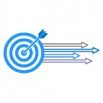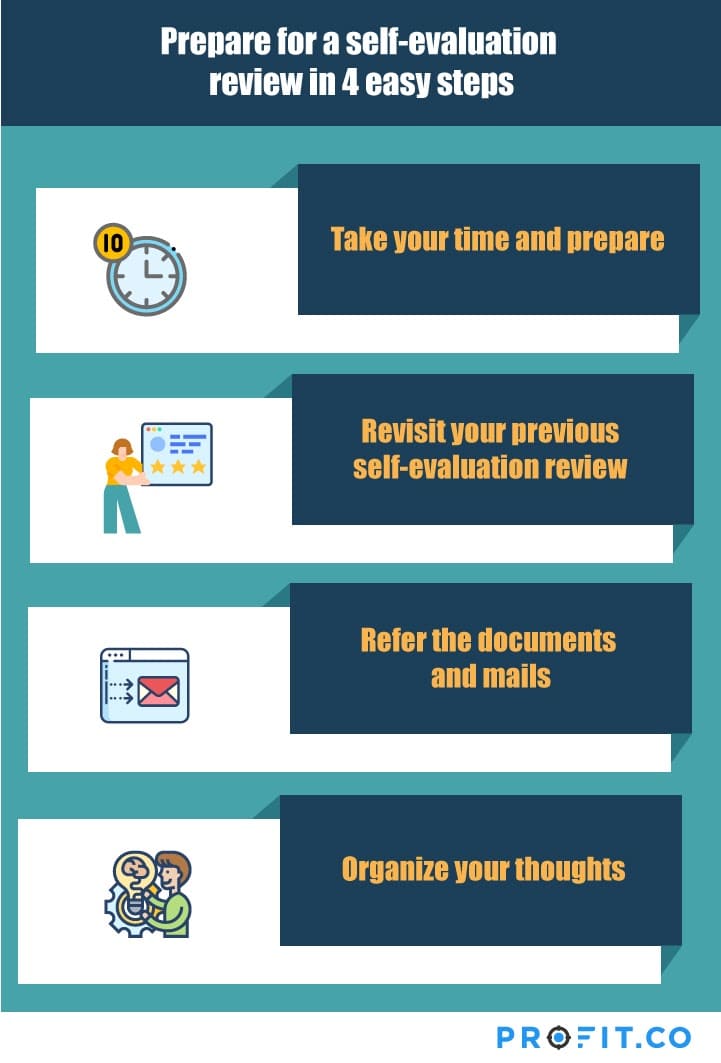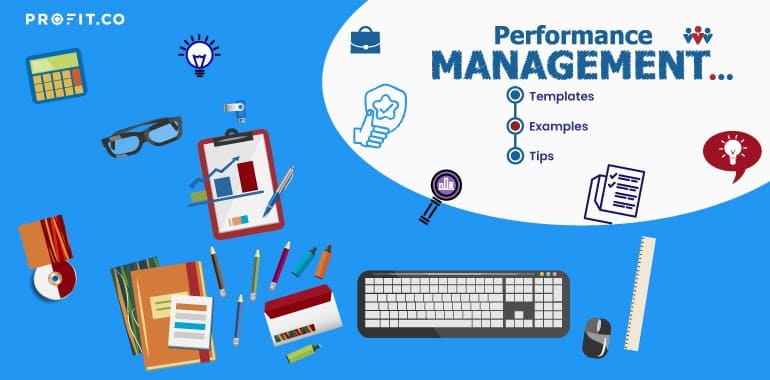Here is a sample employee self evaluation template. Download and customize according to your needs.
In the corporate world, every action is a means to a predetermined end. These predetermined ends are usually the goals you and your team have agreed to achieve on a short or long – term basis.
If you want to reach these goals, it’s important to constantly assess your own work and see if you are performing the necessary tasks and actions to do your part and fulfill your deliverables.
Self Assessment
For that, you need clarity on what your goals are, and how you affect progress. If there is no adequate progress towards the goals, then you have to change your plans and choose a different way to reach them. It is also vital to determine your strengths and weaknesses and the skills or tools required to reach your goals. This is where self assessment comes in.
Self-evaluation directs us to prepare our next performance from the past and today’s experiences.
Why is Self Assessment Necessary?
Self-assessment, as the name suggests is the self evaluation of an employee conducted to meet various objectives. It is a type of employee performance review conducted for the following purposes:
1. Self Assessment helps with self-discovery of an employee
The best person to analyze your actions most fairly is yourself. You know better than anyone else how you perform and where you are in terms of reaching your OKR objectives, what you aspire to become, what you need at work, etc. Therefore, your self assessment is the closest ever reflection of you as an employee and person as a whole.

2. Self assessments helps employees take ownership of tasks, performance, and their career
In this time of the pandemic, it becomes rather more important to analyze oneself, considering most of us are working remotely without any supervision. Self-assessment makes you ask yourself the questions that will help you realize how your autonomous work behavior impacts your work. In the long run, it will help you find the motivation and ability to work from a remote location autonomously. Performance reviews during a pandemic should always include a self assessment.

3. Self assessment helps employees clarify their goals and realign an employee
Employees are absolutely essential to the success of an organization. Their goals are linked to the goals of the organization. As a result, if the employee is not aligned with their goals, he or she will not be able to contribute to the organization effectively. Self assessment helps employees share their understanding of the goals and the progress they have made towards it. It helps the manager verify if they have clarity on their goals, so that if there is a gap in the understanding, the employee can be realigned at the beginning itself.

4. Self assessment helps developing team relationships
While an employee has their own goals to achieve, there is a lot more to achieve as a team. The employee needs to see themself as an integral part of the team. Only then can they understand how their contribution helps the team achieve the overarching company goals. Self assessment also brings out the conflicts and problems within the team. This will help to resolve the problems and make the team more effective and productive.
Are you looking for an intuitive and agile performance management system that allows full integration with your OKR, tasks, and employee engagement software? Look no further than Profit.co! You can sign up for Profit completely free today.

What does Self Assessment Achieve?
Self assessment can be conducted for various purposes. A few of them are listed below:
Assessing the Organization’s Skill Inventory
Companies have to stay agile. When there is an unforeseen need, the organization must be prepared to immediately identify the right person from the workforce and hand over the responsibilities. Finding the right person at such short notice requires a database of skills that can be quickly searched. So, in order to document the skills present in the organization, it is vital to do a skills and competencies audit. When employees can list out their skills in a self assessment, it becomes easy for you to maintain a repository of skills.
Periodic Performance Assessment
Evaluating an employee’s performance in terms of the goals that he or she has achieved helps to establish the correlation between an employee’s achievements and the company’s OKR success. By analyzing how the employee has performed during the review period, the manager can decide how they can best harness the contribution of the employee to further the goals of the organization. Self assessments help ensure that performance reviews get a full picture of performance. Performance management software can further enhance this process by providing tools for comprehensive evaluations and tracking progress over time.
Training Impact Assessment
The purpose of training is for employees to develop new skills or to update existing skills. Organizations spend a lot of their resources training the employees, and it is important to verify that the training has worked. Self assessments help to verify the knowledge gained through the sessions.
Career Development
Self assessments also help uncover an employees’ career aspirations in the organization, where they are currently positioned, and whether they are on track to reach the position they aim to reach. It also helps to assess or revise the pay scale and performance incentives for the employee.
Here is a sample employee self evaluation template. Download and customize according to your needs.
5 Ways Employee Self Assessment Templates Help
Templates are effective self assessment tools. Every performance review has certain objectives. In order to reach these objectives, you have to ask the right questions. What you want to ask the employee depends on what you want to know from them. Employee self assessment templates are like foundations for a review. When you have a proven template, you can easily identify and modify the questions you need to ask your employees and build on the review according to your specific needs.
Before creating or customizing an employee self assessment template, determine the purpose of the review. Customize the template so as to bring out the desired outcomes. Depending on the purpose of the review, you can determine whether you want the outcomes to be numerically measured or narrative in nature. Tailoring your template is a great way to ensure you conduct an effective performance review.
1. Add Relevant Questions:
Add questions relevant to your purpose. Do not add questions that do not bring out the expected outcomes of your review.
2. Customize the Template for every Role:
One template does not fit every role. For instance, the goals, aspirations, achievements, and strengths of a sales executive are completely different from that of a technician. Every position requires different skills and competencies to fulfill their responsibilities. To bring out the best review from each role, the template needs to be customized differently and the questions need to be different. Customize the template in such a way that it brings out the best assessment for those specific roles.
3. Define the Goals and Job Description:
Clearly mention the objective of the review, state the job description and goals set for the particular position. If the review requires the use of a rating scale, describe clearly the ratings on the scale.
4. Measure with the right Rating Method:
Depending on the expected outcomes for the review, you can choose your rating methods. Quantitative measurement helps to easily compare the performance against peers. Qualitative measurement helps to reflect on things in detail. Add quantitative ratings where results are numerically measurable and qualitative ratings wherever the employee needs to reflect on the subject in detail.
5. Mention the review period:
Reviews can be conducted at various intervals. From weekly reviews that help to keep track of ongoing tasks, all the way to annual reviews that are conducted to analyze and evaluate the performance of the employee over an entire year. It is vital to mention the period for which performance is assessed. Failing to mention it can result in the employee mentioning details that are not relevant for the period.
Self assessment Examples : What can you ask in an Employee Self-Evaluation Review?
You can ask various questions in a performance review, depending on the outcomes you expect from the review. Some of the example questions you can ask an employee in a performance self assessment are as follows:
- What are your achievements so far in this review period?
- Do you think you can achieve more?
- What are your short-term and long-term goals?
- What goals have you completed between the last review and this one?
- What are your challenges in achieving goals?
- Do you need to improve or learn new skills to achieve the goals?
- Where do you see yourself in this organization in the future?
- What are your aspirations?
- What aspects of your job do you like and dislike?
- Have you taken up additional responsibilities? Describe them
- What new skills have you acquired in this review period?
- What areas of your work do you need to improve?
- How do you plan to improve?
- Are you able to contribute to your team freely?
- Are your ideas accepted in the team?
- Is your manager supportive of you in completing your tasks and achieving your goals?
- Do you have any problems with the team and its members?
- What are the things you want to change in the team and the organization?
Prepare for a Self-Evaluation Review in 4 Easy Steps:

1: Take your time and prepare
Self assessment is a slow process. It takes time to contemplate goals, achievements, new learnings and everything else you need to put in your review. So, take your time to prepare well so as to ensure that you do not miss anything important.
2: Revisit your previous self assessments
Your previous self assessments contain vital information regarding the goals you had previously set and how you had planned to achieve them. When you fill out a self assessment, it helps you verify if you have followed your plan of action and previously set goals. If you have not achieved your goals, it allows you to reflect on the challenges and identify the ways to overcome them. Revisiting past assessments will help you track your trajectory and get a clear picture of how you have progressed during the review period.
3: Refer to documents and emails
Referring to your calendar, meeting minutes, previous emails and other documents helps you recollect everything you have done in the review period. An important detail you had forgotten and found in these documents could be decisive in career advancement. So, going through them helps a lot in cross-checking and verifying if everything is covered.
4: Organize your thoughts
Presenting your review with the right flow helps you and your manager analyze your performance better. To create the right flow, it is important to organize your points properly before writing the review.
Performance Management and Profit.co
In Profit.co software, self assessments are simpler than ever. Managers and HR administrators can determine what they want to include on performance reviews with highly customizable options for skill-based reviews as well as conversation and feedback-based reviews. These forms can be customized to display specific questions that will create an effective self assessment. Answers are virtually stored and visible to managers and employees alike, so they can be referenced at any point during the review period.
Want to learn more about Profit.co’s options for powerful performance management? Schedule a free demo with our software experts to find out how Profit.co can help your team achieve more!
Final Thoughts
Self assessment templates are highly customizable forms that act as a basis for a sound self-evaluation. With a properly planned review consisting of questions aimed at bringing the best reflection of an employee’s performance, you can achieve the desired outcomes of the review. You can use those outcomes to further the goals of the organization and the employee.
Here is a sample employee self evaluation template. Download and customize according to your needs.

